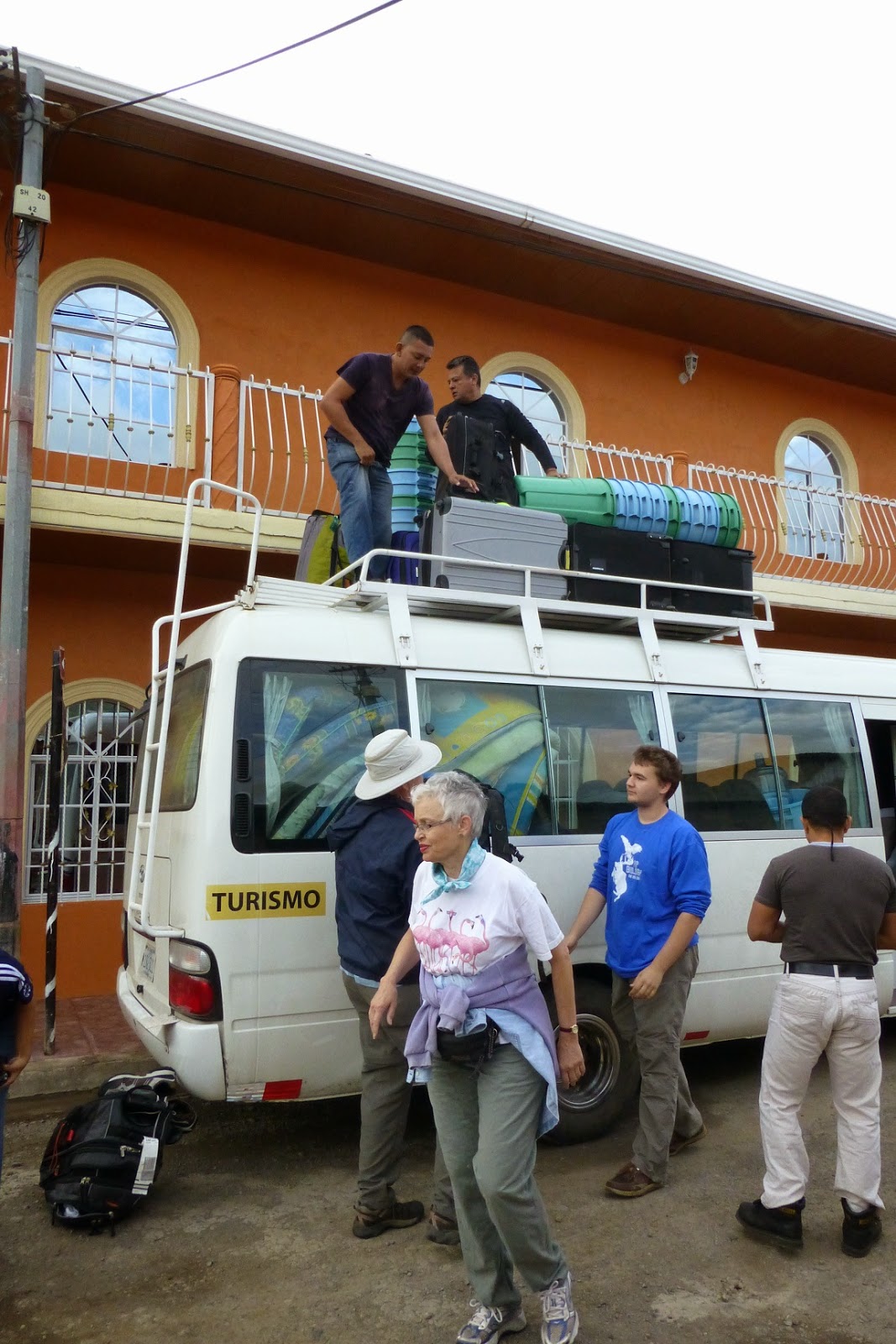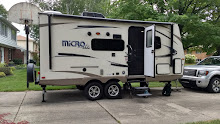Thursday, June 26: During the night, by mutual agreement, women
used one side of the school and men the other for a “pee pad” rather than
making the hike to the latrine in the dark. The sun rose about 5:30 and along
with it the noise level of the animals so, slowly, we did too. After breakfast
of packaged dry toast and jam and Special K cereal we packed up some of the
water purifiers and drove the main dirt road to a side road which deteriorated
more and more, and we took it as far as the bus could drive. Then half of us
climbed in the back of Felix’s pick-up and drove to Chamarro, where the road
ended at Don Felix’s house and the village school. While we waited for the rest
of the group some of us went into the school and talked to the children and
teachers a little bit. The school had three rooms—3-5 year olds, first &
second graders, and third & fourth graders. The 3-5 year olds’ teacher
looked to be about 13 herself but she had a child in the class along with three
other kids! Connie’s Spanish made it possible for us to visit a bit and learn
about the school. We also used the latrines at the school; the only ones in the
community—at their homes, they all “go in the bush”.
One of the things CEPAD has done
in this area is to organize the farms into village-like associations. As the
leader of Zompopera, Don Pedro is sort of in charge of seven associations, each
of which has its own leadership council. CEPAD requires that leadership
councils include women with power and voice. Each council decides what they
want to do for their community for the 5 years while CEPAD works with them.
Putting in the water purification systems is one of the projects the Zompopera
region wanted. All of the rocks, gravel and sand had already been delivered to
the homes that were getting the systems and the leaders worked with us to show
us where the homes were. They also did a lot of the “heavy lifting” along the
way. The homes are not “clustered” in one area like we think of a village and
some were 45-60 minutes hike away from where we began. Don Felix is the
president of Chamarro so he met with us as we were shown how to put the filters
together and set-up one of them in the school. Then we broke into three groups
and headed out in three different directions with the parts to start
installation.
Marv and I were in a group with
Daniel from Agua Clara, Carolina for our interpreter, Carol, and Alex. Don
Felix went with us to carry the barrels and show the way. We hiked up the
hillside, over a creek and through the jungle to the first home, which was his
son’s. His daughter-in-law and 2 year old granddaughter greeted us and we began
our installation. As we would find with most of our installations, the support
shelf where it was being installed was too high for Carol or me to be much
help. The process is to put in the L shaped PVC pipe across the bottom and up
the inside. Then the pipe is added which comes out the predrilled hole near the
top and forms the “spigot” from which the clean water will pour. A layer of
large gravel is put on the bottom, covered with water, and evened out. Then the
barrel is leveled on the shelf. A layer of smaller gravel is added, covered
with water, and again evened out. Half of the sand goes next with more water. A
small packet of shredded copper is mixed with a bowl of sand and makes an
additional layer for ionization. Finally more sand fills up to about an inch
below the spigot and water to cover it. As each layer is added the sides of the
barrel are pounded to “burp” the air pockets out. By the time we got to the top
layer of sand the water was beginning to flow out of the spigot into a catch
pail. The purifier forms a sort of “swamp” biotic layer on top and in 3 or 4
weeks the water that comes out is purified. There are no moving parts and the
only requirement is that water is added twice a day and it never is allowed to
dry out. The oldest ones have been installed for nearly ten years and are still
working. And CEPAD has found nearly 95% being maintained on their revisits,
which they do periodically to check the water purity.
It only took about 15 minutes to
install that one. Then we hiked further up the hill to install our next. This
was a very nice looking pueblo home. It had two rooms off an open entry way. To
the left was the sleeping area and to the right, the kitchen. Like pretty much
every home, there was a two level cooking stove with a fire going and the smoke
exited out an open gable at the top of the wall below the roof. The woman here
had a bandana covering her mouth and we found out from Carolina that she had an
infected tooth that was causing her a lot of pain. While we worked Carolina
tried to convince her that she needed to get an antibiotic. When we finished we
hiked further up the hill until we came to what looked like a cliff. When
Carolina saw that she said, “My Spanish doesn’t go that far” and she sent the
men to do the installation and had Carol and me return to the house, where we
chatted with the woman. As we talked, her teenage daughter returned from
delivering lunch to her father in the field. We found out that the girl really
wanted to go to high school but the only school is the one where we are staying
and it meets on weekends. It would be an hour’s walk at least and there are
drunken men along the way who make it very dangerous. A 15 year old girl had
been killed just a few weeks before and so none of the families wanted their
daughters to go now. She made a point of telling us that there is NOTHING in
their community in the way of health services or education, repeating “Nada,
Nada.” It was pretty depressing and distressing to hear her despair. I will let
Marv describe what they did while we chatted:
It was a very
steep climb to the top of the ridge where we found the next home. It was very primitive compared to the others
we had seen. No brick or adobe; the kitchen walls were made of one and two inch
limbs lashed to a wooden frame. The
living quarters were walled with heavy black plastic. It had a corrugated steel roof just like
every other home we had seen. The view from the ridge top was wonderful, forest
and farm fields all around. We did not meet the mother at this home. The father met us and helped set up the
purifier. The water for the household had to be brought up that same steep hillside
from the stream below. His daughter was there--we had met her at the school
earlier. Like other children we had seen she wore clean clothes and we could
see freshly washed clothes hanging out on a line to dry. She had a new puppy she wanted to show
us. It appeared to have just learned to
walk. Very cute!
After setting up the three
purifiers we made our way back to the school where we were supposed to meet the
other groups around noon and go back to Don Pedro’s for lunch. After waiting a
bit and finding no one else returning, we decided to make do with trail mix and
candies we had with us and bananas from the two bunches Don Felix had picked up
at his son’s house and given to Carolina. We picked up more parts from Felix and
hiked up the steep road to install systems in two more homes in a cluster of
three just off the road. Part of us did one while the rest of our group
installed the other. There was an older woman, her son, and four boys at the
house where I worked but it was unclear who lived in the house. This was a dark
and dreary home and something just seemed off about it. We asked why the boys
weren’t in school and the man said that there was no teacher for them, but
having just been at the school we knew that wasn’t true. We stayed for more
than half an hour waiting in the “yard” for Felix to come and pick us up but
nothing was happening and our frustration was growing. Alex finally decided to
hike back down and see what was going on. We decided that it made more sense
for Felix to take our group back to the bus, since not everyone could ride in
the pick-up truck at one time. So Marv and I followed Alex and convinced Felix
to do just that. William was also available so we returned to the bus. We found
another group there, having put in purifiers in homes near the bus. A small
group of hearty souls hiked up a steep hill to put in one more purifier,
getting caught in the rain on their way back. In the meantime Felix came back
with the last group and we all returned, hot, hungry and very tired, to Don
Pedro’s. We cleaned up a little bit, gobbled down a very welcome dinner, met
briefly to talk about the frustration of the hurry-up-and-wait day and the
conditions we found in Chamarro and to open our Prayer Partner gifts and
collapsed from exhaustion in our beds. Sleep came much more easily that night.
.JPG) |
| Driving to Chamarro |
.JPG) |
| One of the streams the bus had to ford |
.JPG) |
Loading up the truck to continue into Chamarro.
Note what the "road" has become |
.JPG) |
| Connie speaking to a class ofr third and fourth graders |
.JPG) |
Don Felix's granddaughter didn't really want to get her picture taken.
Their new purifier is set up on the shelf behind her and her mom. |
.JPG) |
| Beautiful faces |
.JPG) |
| Daniel, Alex and Peggy climbing the hillside |
.JPG) |
| View from the hillside |
.JPG) |
Farthest up house. Daniel is explaining the purifier's upkeep.
Note the wall construction. |
.JPG) |
| Coffee beans |
.JPG) |
| They may have had oxen to plow this field but all other work is done by hand. |
.JPG) |
| The final purifier of the day was set-up by Grant, Kris, Alex and Marv. |
.JPG)
.JPG)
.JPG)
.JPG)
.JPG)
.JPG)
.JPG)
.JPG)
.JPG)
.JPG)
.JPG)
.JPG)
.JPG)
.JPG)
.JPG)
.JPG)
.JPG)
.JPG)
.JPG)
.JPG)
.JPG)
.JPG)
.JPG)
small.jpg)
.JPG)
.JPG)
.JPG)
.JPG)
